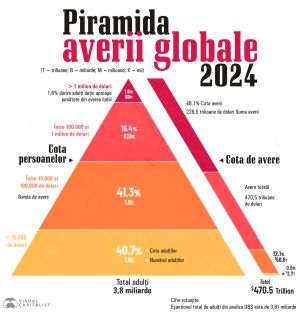The balance of power in the global economy will change dramatically in the coming decades, Goldman Sachs predicts, according to an article published last week by Visual Capitalist.
Analysts of the financial giant believe that, not long from now, Asia will hold the largest share of world GDP, surpassing the traditional economic powers grouped in the category of developed markets (DM), which includes the United States, Germany, Japan, France, United Kingdom or Canada.
According to Goldman's forecasts, in 2050, the Asia area (excluding countries belonging to the category of developed markets) will represent 40% of the global real GDP, over the share estimated for developed countries, of 36%. This would reflect a massive change from the situation in 2000, when the economies of developed countries provided more than 77% of global GDP, according to the source.

The financial group's team expects the economic dynamics of emerging countries to exceed that of developed countries, i.e. a growth of 3.8% compared to 1.8%, with more than half of the difference being due to (relatively predictable) demographic factors rather than differences in productivity growth (less predictable). "In 2050, we estimate that the world's five largest economies (measured in dollars) will be China, the United States, India, Indonesia and Germany (Indonesia replacing Brazil, and Russia being on the list of the largest emerging markets, in this time horizon)", states the report from Goldman, in which 104 countries are taken into account.
According to the financial group's team, China will overtake the United States to become the world's largest economy around 2035.
• The population structure favors Asian countries, according to Goldman Sachs
As for Asia, China and India will account for most of the region's projected GDP in 2050, although China's growth will moderate significantly. The fastest growing economies in Asia in the 2050s will be India (3.1% annually), Bangladesh (3.0% annually) and the Philippines (3.5% annually). "We expect these countries to prosper due to high population growth rates and relatively low median ages, reflecting a larger labor force," the report said.
According to Goldman's estimates, Latin America will have a relatively small share of global GDP in 2050, at 7%. Moreover, many countries in this area have performed poorly over the past decade. For example, Brazil's real GDP has fallen from $2.7 trillion in 2010 to $1.5 trillion in 2020. But because of these regressions, Goldman Sachs believes that Indonesia will be able to overtake Brazil as the largest emerging market in the world before 2050. Even so, the financial group's team expects Brazil to surpass France and Canada by then, according to material published by Visual Capitalist.
• The IMF predicts that India's economy will overtake that of Great Britain this year
The United States is expected to remain the world's largest economy this year, with a nominal GDP forecast by the International Monetary Fund (IMF) of $26.9 trillion. Thus, the US GDP would be greater than the sum of the GDPs of 174 countries ranked from Indonesia - 17th place, to Tuvalu - 191st place, according to another article published by Visual Capitalist, in the date of August 9. China is in second place, with an estimated GDP of $19.4 trillion in 2023. Moreover, the world's top four economies remain in the same positions as in 2022, with the exception of India, which, with an estimated GDP of 3, $7 trillion will overtake Britain, according to the Fund.

By region, the largest economies in 2023 according to IMF estimates will be: Africa - Nigeria (506.6 billion US dollars); Asia - China ($19.4 trillion); Europe - Germany (4.3 trillion); Middle East - Saudi Arabia (1.1 trillion); Central and North America - United States (26.9 trillion); Oceania - Australia (1.7 trillion) and South America - Brazil (2.1 trillion).
• Almost 30 economies will contract this year, the IMF estimates
According to the Fund, this year, 29 world economies will contract compared to last year, with production losses of almost 500 billion dollars, according to IMF estimates, taken by Visual Capitalist. Russia will see the largest decline, estimated at $150 billion this year, equivalent to a third of the decline of all 29 countries with shrinking economies.

Egypt ($-88 billion) and Canada ($-50 billion) together account for another third of lost production. In the case of Egypt, the decrease can be partly explained by the country's currency (the Egyptian pound), whose value has decreased by about 50% against the US dollar since the middle of last year.
Russia and Canada are some of the world's largest producers of oil, the price of which has fallen compared to 2022. In addition, Russia has been forced to sell oil at reduced prices due to sanctions imposed by Western countries. Saudi Arabia, Norway, Kuwait and Oman are also in the top ten countries with the largest projected GDP contractions this year, further highlighting the potential impact of oil prices on producing countries, according to IMF forecasts .
"Recently, producers have cut supply in order to boost prices, but concerns about slowing global oil demand, especially amid a slower Chinese economy (the world's second largest oil consumer), have kept oil prices lower than in 2022" , says the article in Visual Capitalist.
It should be noted that the IMF's forecasts and assumptions were made in the first part of the year, so it is possible to refute them until the end. According to Visual Capitalist, the success of the Fund's GDP forecasts depends on how countries manage to temper inflation without stifling economic growth.
Note: According to Goldman Sachs, making economic forecasts over decades of horizons for more than 100 countries inevitably involves a high degree of uncertainty. However, one of the advantages of making long-term projections is that cyclical risk-an important source of error in short-term forecasts-tends to revert to the mean over time, so that GDP is largely driven by trends in population, capital and technology. A recent example of how expanding the forecast horizon makes the forecaster's task easier comes from China's experience with Covid regulations. The timing of Beijing's abandonment of the Zero Covid policy was a key uncertainty factor for GDP growth in 2023, but matters much less for where China's economy is likely to occupy in the world over ten or twenty years.



























































